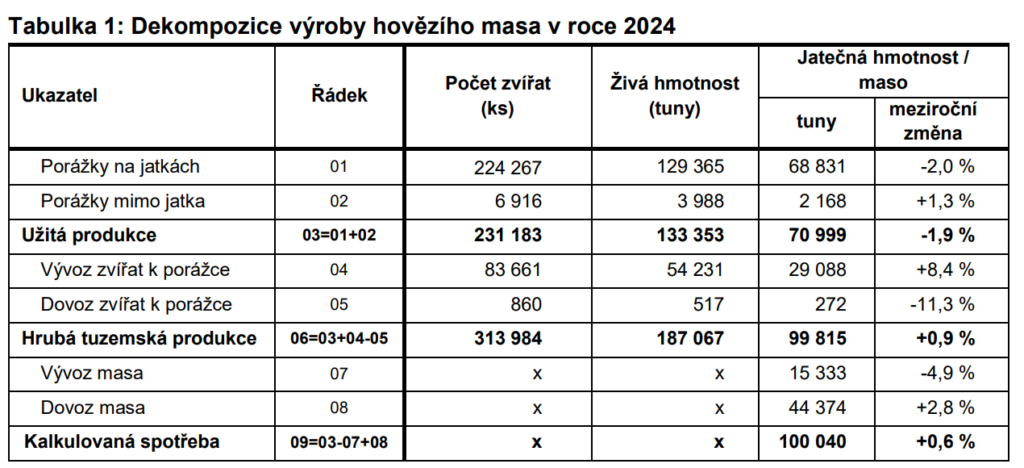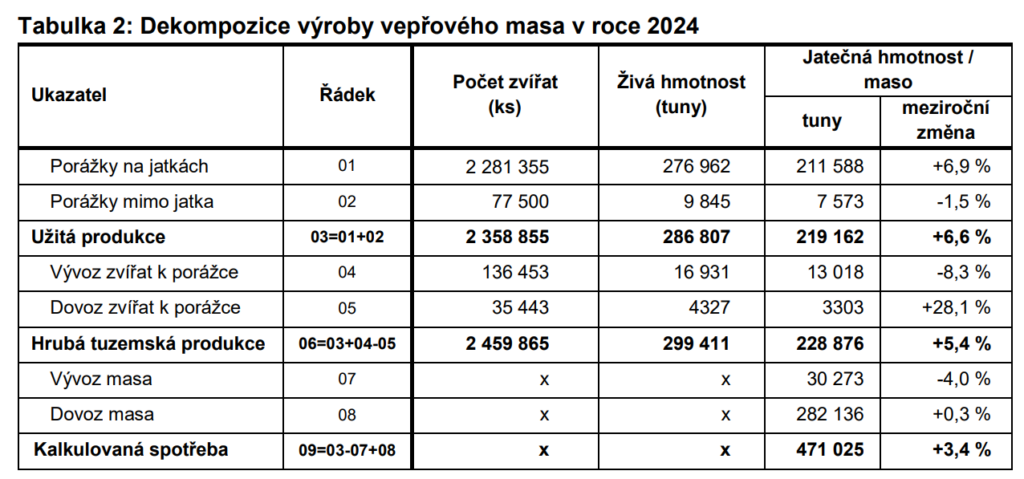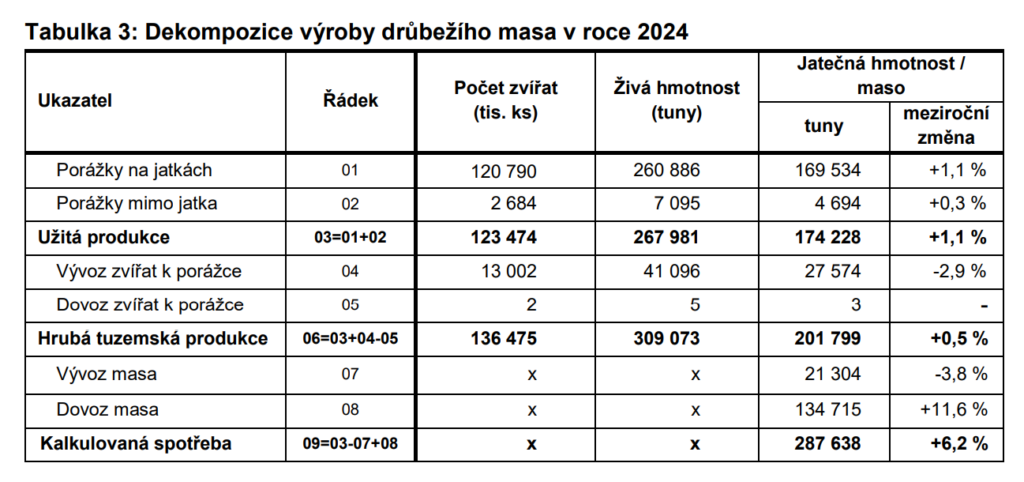In 2024, the same amount of slaughter cattle and poultry was delivered from Czech farms to slaughterhouses in the Czech Republic or abroad, while the supply of slaughter pigs increased year-on-year. In terms of meat (carcass weight), this amounted to 99 815 tonnes (+0.9 %) of beef, 228 876 tonnes (+5.4 %) of pork and 201 799 tonnes (+0.5 %) of poultry. After taking into account the balance of meat imports and exports, the preliminary estimated meat consumption increased year-on-year by 0.6 % for beef, 3.4 % for pork and 6.2 % for poultry.
Beef
In 2024, 68 831 tonnes of beef were produced in slaughterhouses (-2.0 %). The proportion of animals imported from abroad for slaughter in Czech slaughterhouses was negligible.
Exports of animals for slaughter abroad increased by 8.4 %, leaving gross domestic beef production almost the same as in 2023 (+0.9 %). 83.7 thousand cattle were exported for slaughter abroad, i.e. a quarter of the animals fattened in the Czech Republic. The largest sales of this commodity were in Austria, but exports to neighbouring Austria and Germany decreased compared to the previous year, while more slaughter animals were exported to more distant countries (Italy, Hungary, Croatia). Beef was exported 15 333 tonnes (-4.9 %) and imported 44 374 tonnes (+2.8 %), most of it from Poland, while imports from Germany decreased. Beef was exported mainly to Slovakia. Between the Netherlands and the Czech Republic, beef was transported in both directions.
Preliminary beef consumption in 2024 is estimated at 100,040 tonnes, up 0.6 % year-on-year.

Pork
Pork production at slaughterhouses increased by 6.9 % to 211 588 tonnes in 2024.
Gross domestic pork production reached 228 876 tonnes, 5.4 % higher than in 2023. Exports of pigs for slaughter abroad fell by 8.3 %; on the other hand, imports increased by 28.1 1 %. However, imports accounted for only a quarter of exports. Most fattened pigs were exported to Slovakia and Hungary, although exports to both countries fell. In contrast, the quantity of slaughter pigs exported increased significantly to Poland and Germany.
According to preliminary calculations, 471 025 tonnes of pork remained for domestic consumption, up 3.4 % year-on-year. Pork imports were stagnant. Imports were 282 136 tonnes (+0.3 %); exports were 30 273 tonnes (-4.0 %). Most of the imported pork came from Germany, in quantities slightly lower than in the previous year, while higher imports were recorded from Spain. Pork was exported mainly to Slovakia.

Poultry meat
260 886 tonnes of poultry were delivered to slaughterhouses in the Czech Republic in 2024, equivalent to the production of 169 534 tonnes of poultry meat (+1.1 %).
Exports of animals for slaughter abroad decreased slightly year-on-year to 27 574 tonnes carcass weight (-2.9 %), which, with negligible imports, corresponds to almost the same gross domestic production as in the previous year (+0.5 %). This totalled 201 799 tonnes of poultry meat.
An increase in poultry meat imports to 134 715 tonnes (+11.6 %) and a decrease in exports to 21 304 tonnes (-3.8 %) resulted in a preliminary estimate of poultry meat consumption 6.2 % (287 638 tonnes) higher. Meat from Poland dominated almost two-thirds of imported poultry meat, increasing by 18 % year-on-year, while imports from Hungary also increased. From the Czech Republic, poultry meat was exported mainly to Slovakia, Austria and Germany.

Pork production increased by 7.8 %
In Q4 2024 slaughterhouses produced a total of 116 323 tonnes of meat, up 3.2 % year-on-year, of which pork production increased by 7.8 %, poultry production was almost unchanged (+0.2 %) and beef production fell by 2.7 %. Direct purchases of milk from producers declined slightly year-on-year by 0.4 %.
"Even in the last quarter of 2024, the largest contributor to the increase in meat production in slaughterhouses was the increase in pork production. However, slaughter hog prices for farmers have fallen again. In contrast, slaughter cattle prices increased year-over-year, but beef production at slaughterhouses declined. Poultry meat production and slaughter poultry prices showed only slight year-on-year changes," summarized by Renata Vodičková, Head of the Department of Agriculture and Forestry Statistics of the CSU.
"In 2024, pork and poultry production increased after a two-year decline. Although beef production declined, farms retained the potential to produce, with slaughter animals being exported abroad for slaughter to a greater extent. Direct purchases of milk from producers rose for the third year in a row," She added Markéta Fiedlerová, from the Department of Agriculture and Forestry Statistics of the Czech Statistical Office.
Meat production and milk purchase
In the 4th quarter, 60.3 thousand cattle were slaughtered in slaughterhouses, 3.8 % less year-on-year. Slaughterings continued to fall in the bull category (-6.8 %) and the number of cows slaughtered also fell (-2.8 %), but there was an increase in heifer slaughterings (+4.4 %). Production beef reached 18,486 tonnes, the most of any quarter in 2024, yet was 2.7 % lower than in Q4 2023. Pork 55 617 tonnes were produced (7.8 % more year-on-year). 596,1 thousand pigs were delivered to slaughterhouses. Sow slaughterings were up by 17,7 % year-on-year. Poultry slaughterhouses slaughtered 64 852 tonnes of poultry, corresponding to a production of 42 179 tonnes (+0.2 %) poultry meat. 763 124 thousand litres of milk were purchased from domestic producers in the fourth quarter (-0.4 %).
Agricultural producer prices
Prices of slaughter cattle prices increased by 13.6 % year-on-year in Q4, in all categories monitored, with the highest increases for slaughter cows (+16.5 %) and calves (+16.9 %). Breeders received an average of CZK 63.87/kg live or CZK 116.24/kg meat for slaughter bulls. Prices of slaughter pigs were 6.8 % lower year-on-year. The average price was CZK 38.13 per kg live weight or CZK 49.57 per kg carcass weight. However, weaned piglet prices were 5,3 % higher year-on-year. Prices of slaughter chickens decreased by 1.2 % year-on-year. Producers sold carcass grade I chickens at an average of CZK 28.17 per kg live. Prices milk were 17.8 % higher year-on-year. The average price of a litre of Q-quality milk reached CZK 12.10 per litre, which was 91 cents per litre more than in the previous quarter.
CSO/ gnews.cz - RoZ
ILLUSTRATION PHOTO - Amy Vann on Unsplash



